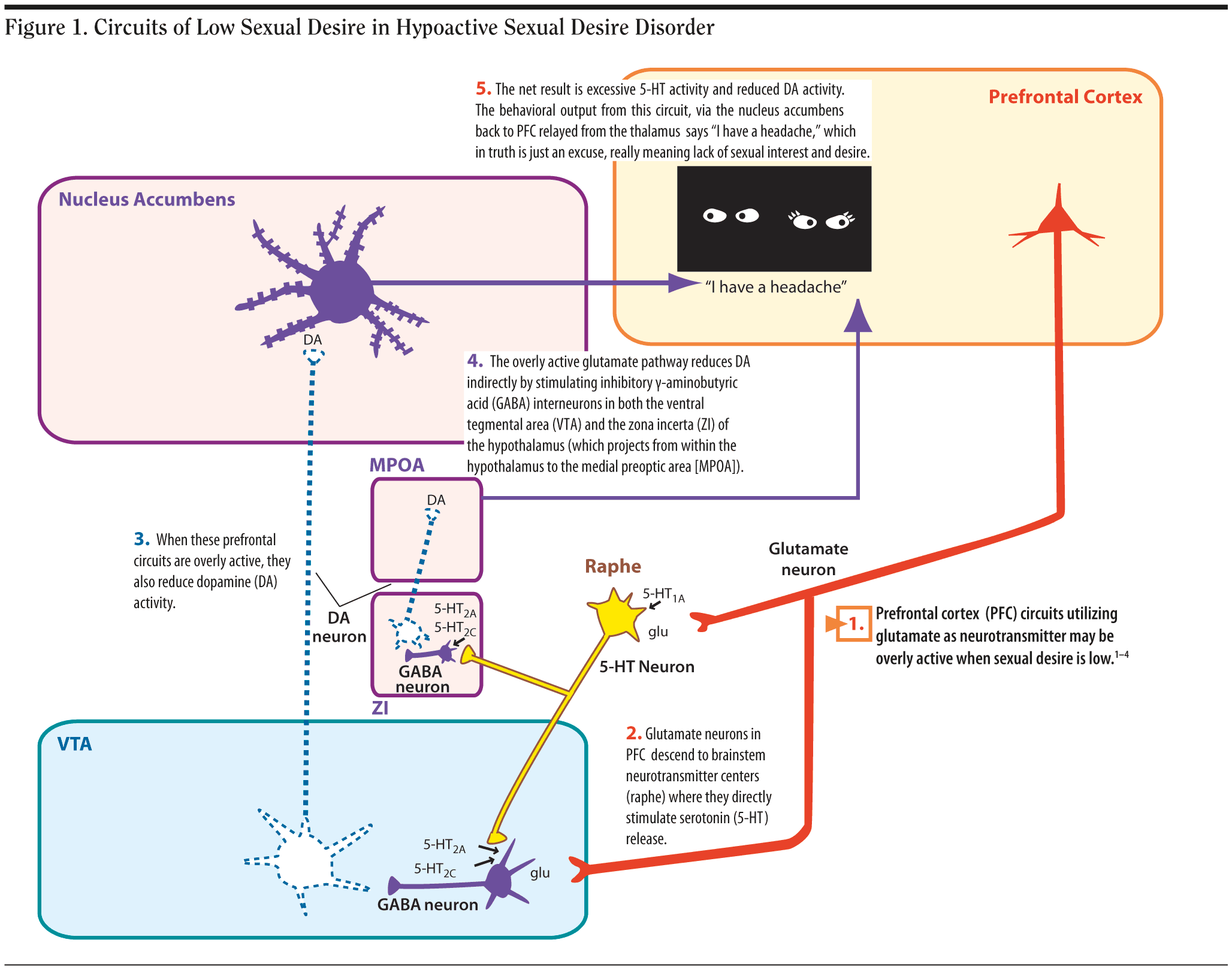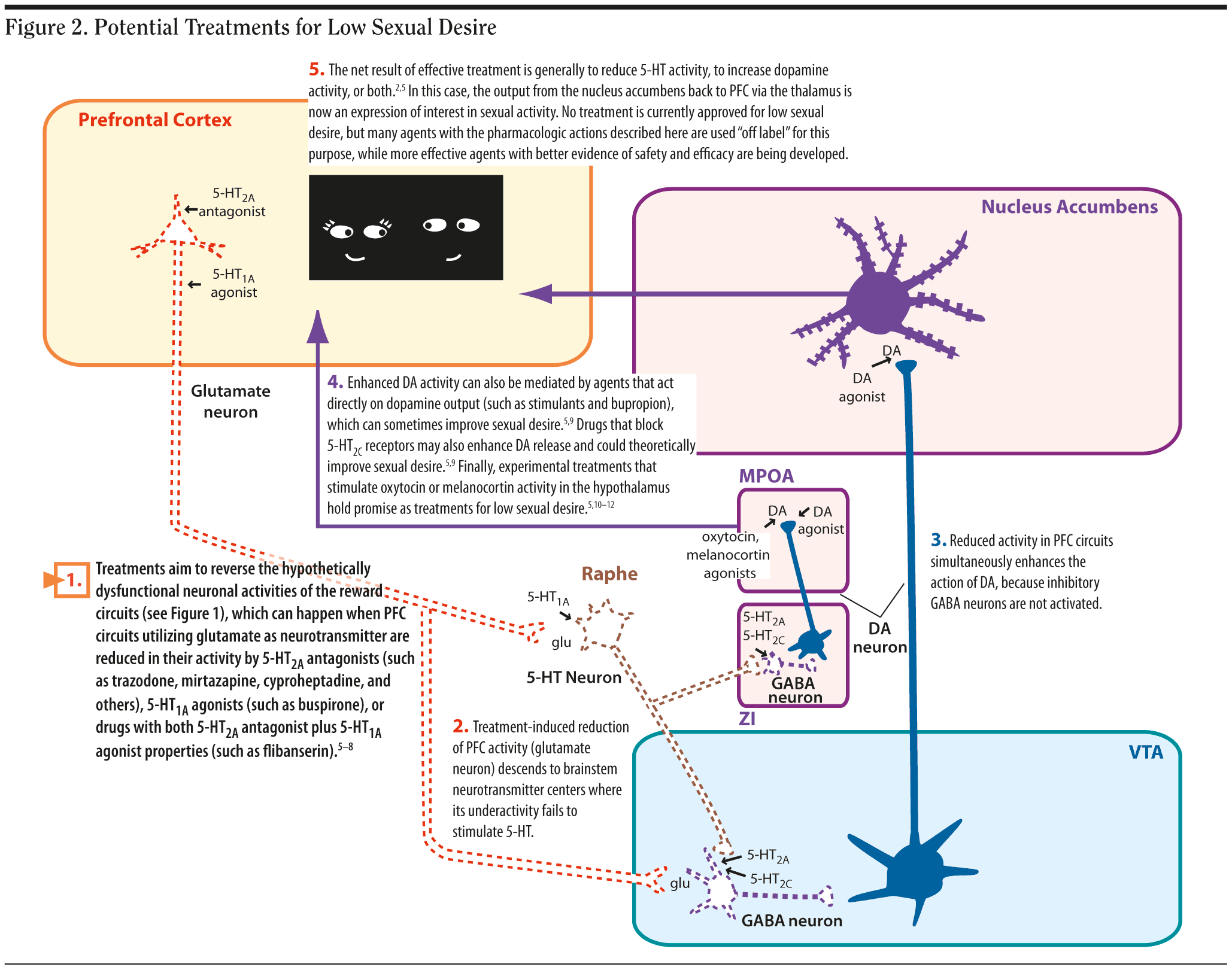
Illustrating the Circuits of Sexual Desire
Stephen M. Stahl, MD, PhD
Issue: Malfunctioning reward pathways may mediate the reduction of sexual desire caused by depression, sexual disorders, endocrine disorders, hormones, and various psychotropic drugs. Effective treatments for reduced libido target these circuits by enhancing dopamine, reducing serotonin, or both.
References
1. Stahl SM. Circuits of sexual desire in hypoactive sexual desire disorder. J Clin Psychiatry. 2010;71(5):518-519. PubMed doi:10.4088/JCP.10bs06115whi
2. Pfaus JG. Pathways of sexual desire. J Sex Med. 2009;6(6):1506-1533. PubMed doi:10.1111/j.1743-6109.2009.01309.x
3. Arnow BA, Millheiser L, Garrett A, et al. Women with hypoactive sexual desire disorder compared to normal females: a functional magnetic resonance imaging study. Neuroscience. 2009;158(2):484-502. PubMed doi:10.1016/j.neuroscience.2008.09.044
4. Holstege G, Willemsen A, Beers C, et al. Differences in brain activity in premenopausal women with hypoactive sexual desire disorder (HSDD) compared to women without sexual dysfunction. Abstracts of the 12th Congress of the European Society for Sexual Medicine (ESSM), November 15-18, 2009; Lyon, France. PS-02-002.
5. Stahl SM. Targeting circuits of sexual desire as a treatment strategy for HSDD (hypoactive sexual desire disorder). J Clin Psychiatry. 2010;71(7):821-822. doi:10.4088/JCP.10bs06117blu
6. Bortolozzi A, D×az-Mataix L, Scorza MC, et al. The activation of 5-HT receptors in prefrontal cortex enhances dopaminergic activity.
J Neurochem. 2005;95(6):1597-1607. PubMed doi:10.1111/j.1471-4159.2005.03485.x
7. Invernizzi RW, Sacchetti G, Parini S, et al. Flibanserin, a potential antidepressant drug, lowers 5-HT and raises dopamine and noradrenaline in the rat prefrontal cortex dialysate: role of 5-HT(1A) receptors. Br J Pharmacol. 2003;139(7):1281-1288. PubMed doi:10.1038/sj.bjp.0705341
8. Jolly E, Clayton A, Thorp J, et al. Efficacy of flibanserin 100 mg qhs as a potential treatment for hypoactive sexual desire disorder in premenopausal women. Abstracts of the 12th Congress of the European Society for Sexual Medicine (ESSM). November 15-18, 2009; Lyon, France. PS-02-008.
9. Stahl SM. Stahl’s Essential Psychopharmacology. 3rd ed. New York, NY: Cambridge University Press; 2008.
10. Hadley ME. Discovery that a melanocortin regulates sexual functions in male and female humans. Peptides. 2005;26(10):1687-1689. PubMed doi:10.1016/j.peptides.2005.01.023
11. Diamond LE, Earle DC, Rosen RC, et al. Double-blind, placebo-controlled evaluation of the safety, pharmacokinetic properties and pharmacodynamic effects of intranasal PT-141, a melanocortin receptor agonist, in healthy males and patients with mild-to-moderate erectile dysfunction. Int J Impot Res. 2004;16(1):51-59. PubMed doi:10.1038/sj.ijir.3901139
12. Rosen RC, Diamond LE, Earle DC, et al. Evaluation of the safety, pharmacokinetics and pharmacodynamic effects of subcutaneously administered PT 141, a melanocortin receptor agonist, in healthy male subjects and in patients with an inadequate response to Viagra. Int J Impot Res. 2004;16(2):135-142. doi:10.1038/sj.ijir.3901200
Brainstorms is a section of The Journal of Clinical Psychiatry aimed at providing updates of novel concepts emerging from the neurosciences that have relevance to the practicing psychiatrist.
From the Neuroscience Education Institute in Carlsbad, California, and the Department of Psychiatry at the University of California San Diego, and the Department of Psychiatry at the University of Cambridge, Cambridge, United Kingdom.
For reprint and financial disclosure information, go to www.psychiatrist.com/brainstorms.
doi:10.4088/JCP.10bs06425whi
© Copyright 2010 Physicians Postgraduate Press, Inc.





